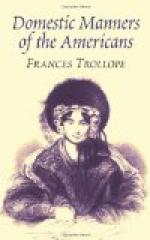Nothing can be less interesting than that part of the state of Delaware through which this cut passes, the Mississippi hardly excepted. At one, we reached the Delaware river, at a point nearly opposite Delaware Fort, which looks recently built, and is very handsome. [This fort was destroyed by fire a few months afterwards.] Here we again changed our vessel, and got on board another of their noble steam-boats; both these changes were made with the greatest regularity and dispatch.
There is nothing remarkable in the scenery of the Delaware. The stream is wide and the banks are flat; a short distance before you reach Philadelphia two large buildings of singular appearance strike the eye. On enquiry I learnt that they were erected for the purpose of sheltering two ships of war. They are handsomely finished, with very neat roofs, and are ventilated by many windows. The expense of these buildings must have been considerable, but, as the construction of the vast machines they shelter was more so, it may be good economy.
We reached Philadelphia at four o’clock in the afternoon. The approach to this city is not so striking as that to Baltimore; though much larger, it does not now show itself so well; it wants domes and columns: it is, nevertheless, a beautiful city. Nothing can exceed its neatness; the streets are well paved, the foot-way, as in all the old American cities, is of brick, like the old pantile walk at Tunbridge Wells. This is almost entirely sheltered from the sun by the awnings, which, in all the principal streets, are spread from the shop windows to the edge of the pavement.
The city is built with extreme and almost wearisome regularity; the streets, which run north and south, are distinguished by numbers, from one to—I know not how many, but I paid a visit in Twelth Street; these are intersected at right angles by others, which are known by the names of various trees; Mulberry (more commonly called Arch-street), Chesnut, and Walnut, appear the most fashionable: in each of these there is a theatre. This mode of distinguishing the streets is commodious to strangers, from the facility it gives of finding out whereabouts you are; if you ask for the United States Bank, you are told it is in Chesnut, between Third and Fourth, and as the streets are all divided from each other by equal distances, of about three hundred feet, you are sure of not missing your mark. There are many handsome houses, but none that are very splendid; they are generally of brick, and those of the better order have white marble steps, and some few, door frames of the same beautiful material; but, on the whole, there is less display of it in the private dwellings than at Baltimore.




